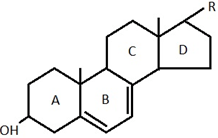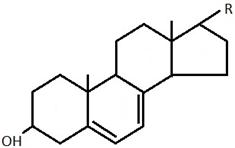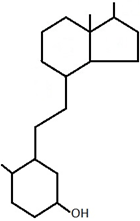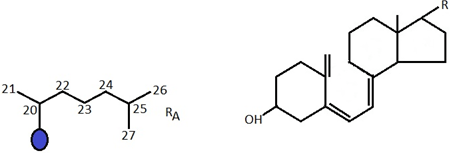This set of Molecular Endocrinology Multiple Choice Questions & Answers (MCQs) focuses on “Mineral Metabolism – Vitamin D”.
1. Which among the following is the cutaneous precursor molecule of vitamin D hormone?
a) 7-dehydrocholesterol
b) Cholecalciferol
c) Calcitonin
d) Parathormone
View Answer
Explanation: The cutaneous vitamin D precursor, 7-dehydrocholesterol, undergoes photochemical cleavage of the carbon bond between the 9 and 10 carbons of the steroid ring when subjected to ultraviolet irradiation. 7-Dehydrocholesterol is potentially present as a side-reaction product of the cholesterol-forming mechanism in abundant amounts in the epidermis.
2. The diagram given below represent which precursor of vitamin D?

a) Lumisterol
b) 7-dehydrocholesterol
c) Previtamin D
d) Tachysterol
View Answer
Explanation: 7-Dehydrocholesterol is present in the epidermis in abundant amounts, possibly as a cholesterol-forming side-reaction product. This 5,7-unsaturated sterol is present in the epidermis in extraordinary quantities, possibly because it is a vitamin D precursor.
3. Which inert isomer of Previtamin D is represented in the diagram given below?

a) Dihydrotachysterol
b) Tachysterol
c) Lumisterol
d) Ergocalciferol
View Answer
Explanation: Previtamin D, thermally labile, can be isomerized into two biologically inert drugs, lumisterol and Tachysterol. Lumisterol is depicted in the diagram here. With extended sun exposure, this alternative photoisomerization avoids the development of excessive quantities of vitamin D.
4. State whether True or False. Vitamin D is not a true vitamin.
a) True
b) False
View Answer
Explanation: Vitamin D is not a true vitamin, because in people who have sufficient sun exposure, nutritional supplementation is not needed. With extended sun exposure, this alternative photoisomerization avoids the development of excessive quantities of vitamin D.
5. State whether the given statement is true or false. Fortified dairy products are the main dietary sources of vitamin D.
a) True
b) False
View Answer
Explanation: Fortified dairy products are the main dietary sources of vitamin D, however the lack of control of this supplementation results in a marked difference in the amount of vitamin D given. Egg yolks, fish oils, and fortified cereal products are other food sources.
6. What is the configuration of 3-hydroxyl group of Dihydrotachysterol given below, which is produced from Tachysterol?

a) 1-hydroxy
b) Pseudo-1-hydroxyl
c) Pseudo-3-hydroxyl
d) Pseudo-2hydroxyl
View Answer
Explanation: The Dihydrotachysterol 3-hydroxyl group is in a pseudo-1-hydroxyl configuration. In conditions associated with low 1 alpha-hydroxylase activity, this can explain the relatively high potency of Dihydrotachysterol.
7. The structure given below represents which from of Vitamin D?

a) Vitamin D3
b) Vitamin D2
c) Previtamin D
d) Dihydrotachysterol
View Answer
Explanation: The structure given here, represents Vitamin D3 which is otherwise known as cholecalciferol. Vitamin D is a group of fat-soluble secosteroids that are responsible for increasing calcium, magnesium, and phosphate intestinal absorption, and many other biological effects. In humans, vitamin D3 (also known as cholecalciferol) and vitamin D2 (ergocalciferol) are the most significant compounds.
8. Vitamin D is absorbed into the lymphatics and enters the circulation by binding to which protein?
a) CBP
b) CREB
c) PRGC
d) VDBP
View Answer
Explanation: Although a fraction of vitamin D circulates bound to albumin, vitamin D is absorbed into the lymphatics and reaches the circulation bound mainly to vitamin D-binding protein (VDBP). A 52-kd al-globulin that is synthesized in the liver is the human VDBP.
9. The vitamin D-binding protein (VDBP) has more affinity towards which form of vitamin D?
a) 25(OH)D
b) Vitamin D3
c) Ergocalciferol
d) Previtamin D
View Answer
Explanation: Human VDBP has a high 25(OH)D (25-hydroxyvitamin D) affinity, but it also binds to vitamin D and calcitriol. Around 88% of 25(OH)D circulates bound to the VDBP, 0.03% is free, and the remainder circulates bound to the albumin.
10. In the diagram given below, which shows transcriptional activation by 1,25-dihydroxyvitamin D3, which is the molecule that binds to the sequence along with RXR?

a) VDBP
b) VDR
c) CREB
d) CBP
View Answer
Explanation: A retinoid-X receptor (RXR) and vitamin D receptor (VDR) heterodimer binds to a pair of hexameric sequences separated by three bases that interfere (ATG). Arrows suggest that variants of a consensus sequence, repeated here with similar orientations, are the hexamers found in the upregulated rat osteocalcin gene (direct repeats).
11. VDR-RXR heterodimers in the transcriptional activation by 1,25-dihydroxyvitamin D3 repress which enzyme?
a) 1α-hydroxylase
b) 1α-translocase
c) 3-beta aromatases
d) Lyase isomerase
View Answer
Explanation: The mechanism of vitamin D transcriptional repression is different. For instance, by blocking the role of other transcription factors, VDR-RXR heterodimers repress the 1 alpha-hydroxylase and renin genes, while interaction of the VDR with the Ku antigen, acting as a transcription factor, is needed for human PTHrP gene transcriptional repression.
12. Glucocorticoids have been shown to decrease the expression of the VDR gene in which cell lines?
a) Osteosarcoma cell lines
b) Adenocarcinoma
c) Dalton’s Ascites Lymphoma
d) Myeloma
View Answer
Explanation: In osteosarcoma cell lines, glucocorticoids have been shown to decrease the expression of the VDR gene, while calcitriol increases its expression in many cells. Calcitriol, however, reduces VDR levels in the renal proximal convoluted tubule.
13. Which among the following is an example of vitamin D analogue?
a) 22-oxacalcitriol
b) 98-oxocolcalciferol
c) 22-cholecalciferol
d) Vasotriol-9
View Answer
Explanation: 22-oxacalcitriol is a non-hypercalcemic analogue of vitamin D. In rats, this has been shown to inhibit PTH synthesis and secretion at doses that promote the absorption of intestinal calcium less than calcitriol does. This indicates that in the prevention and treatment of hyperparathyroidism, such analogues may be useful.
Sanfoundry Global Education & Learning Series – Molecular Endocrinology.
To practice all areas of Molecular Endocrinology, here is complete set of 1000+ Multiple Choice Questions and Answers.
If you find a mistake in question / option / answer, kindly take a screenshot and email to [email protected]
